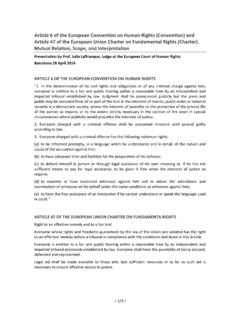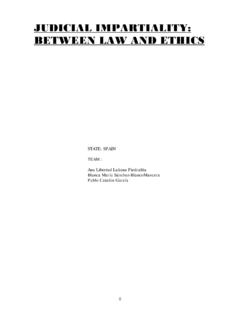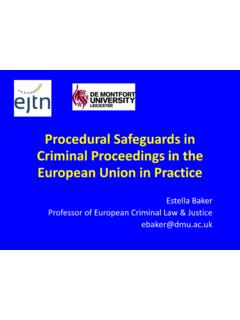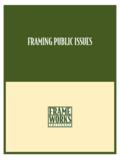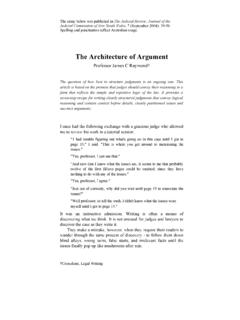Transcription of Legal Reasoning of the Court of Justice in the Context of ...
1 EUROPEAN & INTERNATIONAL LAW Legal Reasoning of the Court of Justice in the Context of the Principle of Equality Between Judicial Activism and Self-restraint By Oreste Pollicino* Those with a taste for fairy tales seem to have thought that in some Aladdin s cave there is hidden the Community law in its splendour and that on a judge s appointment there de-scends on him knowledge of the magic words Open Sesame. Bad decisions are given when the judge has muddled the password and the wrong door opens.
2 But we do not believe in fairy tales any more. 1 A. Introduction The law-making function of judges in general, and more specifically of the judges of the Court of Justice , was and continues not only to provoke debates and confron-tations between different doctrinal opinions, but also to act as a battleground for opposing ideologies regarding the functions, powers and limits of the judiciary in our society. The issues involved are by nature trans-sectorial, (with aspects of a Legal , social, economical and political nature), and thus cannot be restricted to a single field of inquiry.
3 The difficulty of this subject would have made a general approach presumptuous. I thus preferred to restrict my study to an analysis of some of the decisions made by the Court of Justice regarding the principle of sex equality. This is a field of inquiry which is particularly suitable for identifying the decisional techniques of the Court , as well as for understanding the concepts of judicial activism and self-restraint and their respective limits. Such an analysis re-quires that we place our conclusions in the Context of a general framework, and establish parameters to help us recognize a creative decision and evaluate its out-come.
4 The first part will deal with the following issues: underlining what I consider the real meaning and extent of a judge s power, with particular emphasis on the spe- * Master in European law, Bologna University; LLM in European law ,College of Europe, Bruges; PhD in Costitutional law, Milan University; Lecturer in Public law, Bocconi University, Milan. 1 Lord Reid, The Judge as Law Maker, 12 JOURN .SOC. PUB TEACH LAW 22 (1972). 284 [Vol.]
5 05 No. 03 GERMAN LAW JOURNAL cific role of the European Court of Justice , and identifying and evaluating law-making judicial operations. In the second part, in the light of the framework and the criteria outlined in the first part, I will focus my analysis on three paradigmatic cases in the Context of the prin-ciple of equality in order to apply in practice the theoretical conclusions reached in the first chapter. The third and concluding part will tackle the problem of the present and future constitutional features of the European Judicature, examining if and to what extent the Court of Justice acts as a Constitutional Adjudicator.
6 B. Examining the Law-making Function of the Courts in General and of the Euro-pean Court of Justice in Particular Ever since the creation of the European Community, the Court of Justice has not simply been a group of judges with expertise in European law, but has represented one of the real driving forces of European integration. In other words, if today there exists something called law, with its own particular features, characteristics, and issues, all this is due to the Court s work. As, in a well known piece, Stein wrote of it, tucked away in the fairyland Duchy of Luxemburg and blessed, until recently, with the benign neglect by the powers that be and the mass media, the Court of Justice of the European Communities has fashioned a constitutional framework for a federal-type structure in Europe.
7 2 The masterpiece of the Euro-pean Court has been the constitutionalisation of the Treaties, which, by nature, are sources of international law. It would have been inconceivable to bring about such a radical transformation without applying a degree of judicial creativity. Of course, every conquest has its price, and the Court has had to pay the price of no longer being subject to benign neglect but becoming, on the contrary, the target of harsh accusations and the 2 E.
8 Stein, Lawyers, Judges and the Making of a Transnational Constitution, A. J. INTN L L. 1 (1981). 2 H. RASMUSSEN, ON LAW AND POLICY IN THE EUROPEAN Court OF Justice (Martinus Nijolf ed., Copen-hagen 1986); H. Rasmussen, Between Self restraint and Activism: A Judicial Policy for the European Court , 13 EUR. L. REV. 28 (1988); P. Neill, The European Court of Justice : a Case Study in Judicial Activism, 218, Inter-governmental Conference, Minutes of Evidence, House of Lords 1996. 2004] 285 Legal Reasoning of the Court of Justice beneficiary of valiant defences for the way in which it has interpreted its judicial I do not intend to deal directly with the legitimacy of the Court s role.
9 Rather, I would like to examine the relations, first in a general Context and then in a Com-munity framework, between the scope of judicial functions and the necessity of judicial creativity. By adopting this approach it will be possible to better under-stand the peculiarity of the European judicature and its importance in the process of European integration. After having examined the various options highlighting the nature and essential features of judicial activism, so widely studied and discussed by Legal scholars, I shall apply the a contrario method.
10 In following this approach I will try to under-line what law making is not, in order to eliminate possible misunderstandings and misleading definitions, and thus allow the authentic nature of law making to emerge. In particular, I will contest the validity of three assertions that are frequently brought up in the debate on this issue. These assertions, which, if taken seriously, prevent us from realising the essence of judicial law-making power, are: 1) Such power is not implicit in the judicial function, but is a degeneration of it.




